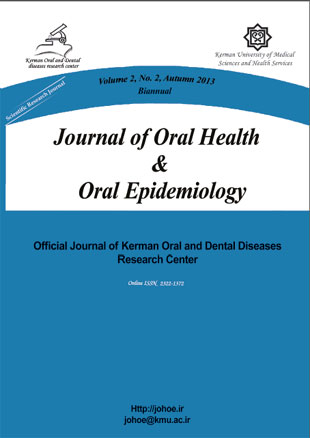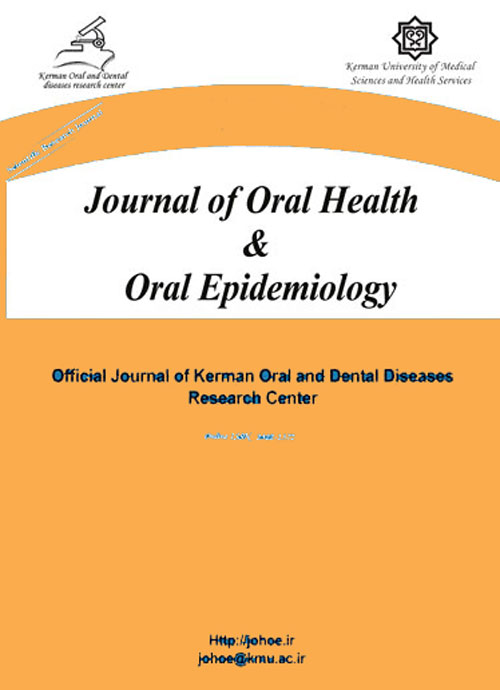فهرست مطالب

Journal of Oral Health and Oral Epidemiology
Volume:2 Issue: 2, Summer-Autumn 2013
- تاریخ انتشار: 1392/07/23
- تعداد عناوین: 8
-
-
Page 1Background And AimAll primary care providers contribute to oral health promotion of the community, especially when they are more frequently visited by individuals compared to dentists. The aim of the present study was to assess midwifery students’ knowledge on and attitude toward oral health promotion of pregnant women and its relationship with the students’ own oral health status and their backgrounds.MethodsIn a cross-sectional study, a questionnaire was distributed among all midwifery students of Tehran University of Medical Sciences (n = 104). The questions consisted of information on their demographic data and knowledge on and attitude toward oral health during pregnancy. The students’ oral health status was assessed in terms of decayed, missing or filled teeth (DMFT), community periodontal index of treatment need (CPITN), and plaque index (PI). The data were analyzed by Kruskal-Wallis, ANOVA, NPAR tests, and logistic regression analysis.ResultsThe mean scores of the students’ knowledge about oral health were 5.2 ± 0.9 (maximum score = 8), attitude toward oral health 22.4 ± 4.8 (maximum score = 40), and attitude toward oral health of pregnant women 67.5 ± 11.5 (maximum score = 120). The mean DMFT was 4.55 (SD = 3.19), max CPITN was 1.48 (SD = 0.81) and PI was 0.9 (SD = 0.46). There was a significant relationship between oral health attitude and students’ mean DMFT, PI, and max CPITN (P = 0.005, P = 0.005, and P = 0.011), but there was no significant relationship between these indices and the knowledge of the students.ConclusionThe students seemed to have limited oral health knowledge and fairly negative attitudes, while better oral health status was related to a more positive attitude among them. Negative oral health attitude could affect their role in education of patients; therefore, it is necessary to incorporate oral health promotion educations in their curriculum.Keywords: Midwives, Knowledge, Attitude, Oral Health
-
Page 56Background And AimThe aim of this cross-sectional study was to evaluate the knowledge and attitude of school teachers regarding root canal therapy (RCT) in Kerman, Iran.Methods403 teachers participated in this study (49.9% were female and 46.9% were male). Data collection was performed by a researcher-made questionnaire. After checking the validity and reliability of the questionnaire, it was distributed among teachers. The questionnaire consisted of three parts: demographic information, knowledge, and attitude. To analyze data, descriptive statistic and inferential analysis were done by two-sample t-test and one-way analysis of variance.ResultsMean scores of knowledge questions regarding RCT in men and women were 57.23% and 48.97% (P < 0.05), respectively. In addition, mean scores of the attitude of men and women were 70.53% and 71.07%, respectively (P > 0.05). In the knowledge part, it was shown that education level influences the knowledge of the participants being studied (P < 0.05). There was no significant correlation between the amount of knowledge and attitude (P > 0.05).ConclusionsThe knowledge level of the school teachers was moderate and their attitude was good.Keywords: Knowledge, Attitude, Teachers, Root Canal Therapy (RCT)
-
Page 64Background And AimDue to their antimicrobial and dental plaque control activity, mouthwashes lead to an improvement in oral health. Although chemical mouthwashes have demonstrated the greatest antimicrobial and anti-inflammatory effects, their usage has been limited because of their numerous side effects. This study was conducted in vivo to determine the antibacterial and antifungal effects of Persica herbal mouthwash containing Salvadore persica, mint, and yarrow in comparison with a placebo.MethodsIn this experimental, single-blind study, 80 dentistry students, who were eager to participate in the study, were randomly allocated into two groups of forty. One group was given Persica while the other group received a placebo. They were asked to apply the mouthwash twice a day for four weeks. The participants were unaware of the mouthwash type. Saliva sampling was conducted in all cases before and after mouthwash application and the samples were dispatched to a laboratory for microbial culture (Sabouraud and Clark-Kenner media culture). After two weeks, the washout times in groups were swapped with each other and the sampling was conducted just like before. Finally, the data were analyzed using independent and paired t-test. P values of less than 0.05 were considered significant.ResultsThe mean age of participants was 23.20 ± 4.14. Persica mouthwash significantly decreased the count of Candida albicans (1.43 ± 0.15 to 0.8 ± 0.35) (P < 0.001) and Enterococcus faecalis (0.93 ± 1.76 to 0.71 ± 2.10) (P = 0.008).ConclusionThe statistical tests revealed that applying Persica mouthwash would result in a significant decrease in the Candida albicans and Enterococcus faecalis count. Regarding the significant and desirable effect of Persica on Candida albicans and Enterococcus faecalis, and its herbal origin, its application could be suggested to reduce oral microbes and infections from fungi and enterococci.Keywords: Herbal Mouthwash, Persica, Candida Albicans, Enterococcus Faecalis, Oral Microbes, Saliva
-
Page 70Background And AimDigital panoramic X-ray images can be captured using photostimulable phosphors or solid-state detectors (i.e. charge-coupled devices and Flat-Panels). The first category is defined as computed radiography (CR) or semi-direct radiography. The second technology that uses solid-state detectors is known as direct digital radiography (DDR). Both of these technologies have their own advantages and disadvantages. One of the most important fields in comparison of these systems is their resultant image quality. The purpose of this study was to compare the subjective image quality of DDR and CR digital panoramic system, and to assess the overall density and contrast of their images.Methods200 patients were randomly allocated to two digital systems: Promax [central control digital (CCD)] and XC [photostimulable phosphor plates (PSP)]. Image quality was evaluated in six regions on a 3-point scale by three oral and maxillofacial radiologists independently. In addition, observers assessed overall density and contrast of each image on a 3-point scale.ResultsUsing chi-square test, no statistically significant differences were found (P >0.05) in subjective image quality of anatomic structures between the two radiographic systems. But DDR system outperformed CR system in overall density and contrast of the image. P values for both overall density and contrast of the images was less than 0.001.ConclusionsThe subjective image quality of CR and DDR panoramic systems in specified anatomic regions were found statistically comparable in this study. In overall density and contrast of the radiographs, DDR system proved better than CR system.KEYWORDS:Keywords: Dental Radiography, Digital Dental Radiography, Panoramic Radiography, Direct Digital Radiography, Computed Radiography
-
Page 75Background And AimTrauma is a common problem among blindness and visually impaired children. The purpose of the current study was the assessment of the prevalence of traumatic dental injuries and the enamel defects resulted from these injuries among 6-12 years old blind children in comparison to the sighted children in Kerman.MethodsIn this cross-sectional study, sample size was considered as census. All of 80 blind elementary school children that lived in Kerman, Iran, were examined and 80 sighted students were examined as control group. Data were collected by clinical examination of the permanent incisor teeth and a valid check list. Data was analyzed by SPSS software version 16 and chi-square statistical test.ResultsRegarding the history of trauma to the incisor primary teeth, there was statistically significant difference between the two groups. The blind children had significantly higher percentage of traumatic injuries to their incisor permanent teeth than the sighted children. There was a statistically significant difference regarding the prevalence of the enamel defects on labial surface between the two groups.ConclusionsBlind children are at risk of multiple traumatic dental injuries and subsequently the enamel defects. So they need more attentions and care for preventing this type of morbidity.Keywords: Blindness, Trauma, Hypoplasia, Dental Injuries
-
Page 81Background And AimThe aim of the present study was to evaluate the effect of different needle-insertion depths on the accuracy of the Root ZX II and Root ZX mini apex locators in the presence of various irrigants.MethodsNinety extracted single-canal human teeth were used in nine experimental groups. The coronal one-third of the canals was preflared, and the length to the major foramen was determined visually under a microscope. The teeth were embedded in an alginate model. NaOCl concentrations of 5.25%, 2.60%, and 2.00% chlorhexidine with three endodontic needles (21, 25, and 30 gauges) were delivered into the root canals of teeth in each group. Electronic length was determined with both devices using K-files of size 10. The results obtained with electronic apex locators were compared with the corresponding actual length. A multivariate linear regression model was used to determine the variables influencing the accuracy of the Root ZX II and Root ZX mini apex locators.ResultsIrrigant solution concentrations had no effect on the accuracy of the measurements with these locators (P = 0.83). The statistical analysis of the results showed EAL accuracy to be 100% for both Root ZX and Root ZX mini, within a tolerance of ± 0.5 mm. Data were analyzed by ANOVA. Multivariate linear regression model demonstrated that needle-insertion depths influenced the electronic measurements (P = 0.05), while the concentrations of irrigants did not influence the results.ConclusionUnder the conditions of this ex vivo study, needle-insertion depths influenced the electronic measurements.Keywords: Irrigation, Needle Gauge, Sodium Hypochloride, Chlorhexidine, Working Length, Apex Locator
-
Page 97Background And AimHepatitis B Virus (HBV), a DNA virus with a human-only reservoir, is a worldwide public health problem. Approximately 45.0% of the world’s population is considered to live in areas of high endemicity with a lifetime risk of infection of more than 60.0%. The present study aimed to assess the level of understanding and awareness about Hepatitis B immunization among the first and second year dental students at a private dental institution in Mangalore, Karnataka, India.MethodsA cross-sectional survey was carried out using a self-administered pretested questionnaire containing 10 questions on awareness about prevention and transmission, diagnosis and treatment of Hepatitis B, vaccination status of hepatitis B, and awareness of students regarding post exposure prophylaxis. Descriptive analysis was carried out and was presented as number. Student’s t-test was used to determine any significant differences between the genders, and year of study.ResultsThe response rate was 100% (n = 179). About 59.7% of the students were aware of the Hepatitis B infection and its effects. Majority of the students (91.0%) were immunized by hepatitis B vaccine. Majority of the students (96.0%) felt it was necessary to be immunized against the Hepatitis B virus. About 69.8% of the students were aware of post exposure prophylaxis against Hepatitis B. A vast majority (96.0%) of the students felt that awareness about immunization against Hepatitis B among the community is necessary.ConclusionMajority of the students are aware of Hepatitis B, its infection, its vaccination, and its importance.Keywords: Immunization_Awareness_Hepatitis B Virus_Infection_Post Exposure Prophylaxis


